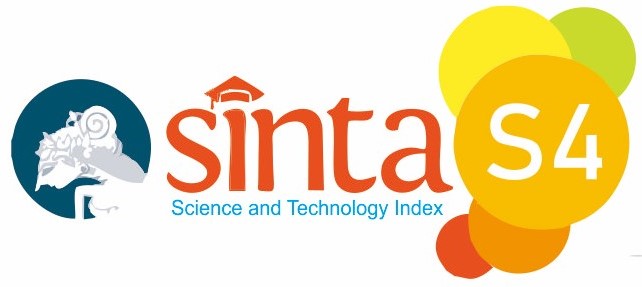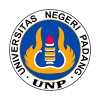HOSE AND DUST COLLECTOR BRACKET DESIGN WITH 3D PRINTER MATERIAL PETG FILAMENT FOR CNC ROUTER
Abstract
The challenge of a CNC Router is the dust and small particles produced during the cutting process such as wood, aluminum or acrylic materials. These small particles can disturb the health of operators. 3D printing is a technology where materials are arranged layer by layer to produce three-dimensional products. PETG filament is a type of polymer that has a density of 1.38 g/cm3 and has the advantage of being weather resistant, not being damaged or losing color when exposed to UV light. PETG filament uses a printing temperature of 230°C-265°C. This bracket is designed to hold hoses and dust collector. The Bracket design can be installed on a CNC router machine without interrupting the cutting process or reducing the quality of the final result. The method used is Autodesk Inventor Professional 2023 student edition software for 3D design and UltiMaker Cura for the slicing process. This research resulted in a bracket design and prototype using a 3D printer. The bracket exhibits sufficient structural capability to hold the cooling hose and dust collector. There is a dimensional difference between the design measurements and the workpiece that has been made of 0.27 mm in the CNC Router head diameter and 0.1 mm in the hose diameter. This is due to the work tolerances and parameters used on the 3D printer machine. By implementing the Hose and Dust Collector Bracket, it is hoped that small particles can be reduced so that a clean and dust-free work environment can improve operator health and comfort.
References
Amaluddin, M. N. H., & Jamaludin, R. (2023). Modifikasi Rancangan Bracket Caliper Menggunakan Mesin CNC dengan Metode Perancangan VDI 2221. Journal of Energy, Materials, & Manufacturing Technology, 2(01), 59–66. https://doi.org/10.61844/jemmtec.v2i01.377
Avriansah, R., Erwanto, & Pristiansyah. (2022). Optimasi Parameter Proses 3D Printing terhadap Kekuatan Tarik Filament Polyethylene Terephthalet Glycol. Prosiding Seminar Nasional Inovasi Teknologi Terapan, 2(1), 394–400.
Barrios, J. M., & Romero, P. E. (2019). Improvement of surface roughness and hydrophobicity in PETG parts manufactured via fused deposition modeling (FDM): An application in 3D printed self-cleaning parts. Materials, 12(15), 2019–2020. https://doi.org/10.3390/ma12152499
Budiawan, F., Wijaya, A. B., Suminar, R. R., & Halim, D. A. (2023). Reverse Engineering Katup Kompresor Angin Kaji dengan CNC Router. Vomek, 5(4), 1–8.
Didit, A. (2021). Uji Pengaruh Kecepatan dan Perbedaan Suhu Antara Filment PLA Dengan Filament PETG Pada 3D Printer Ender 5 Pro. In Tugas Akhir. POLITEKNIK HARAPAN BERSAMA TEGAL.
Hendrawan, A., Lubis, G. S., & Wicaksono, R. A. (2023). Optimasi Parameter Proses terhadap Geometris Dimensi pada Proses Cetak 3D Printing Berbahan Polyethylene Terephthalate (PET) Menggunakan Metode Taguchi. Jurnal Teknologi Rekayasa Teknik Mesin (JTRAIN), 4(1), 30–37.
IEMAI. (2024). PETG Technical Data Sheet (TDS). Dongguan Imai Intelligent Technology Co. https://www.iemai3d.com/wp-content/uploads/2020/12/PETG_TDS.pdf
Pristiansyah; Hardiansyah; Sugiyarto. (2019). Optimasi Parameter Proses 3D Printing FDM Terhadap Akurasi Dimensi Menggunakan Filament Eflex. Manutech: Jurnal Teknologi Manufaktur, 11(01), 0–7. https://media.neliti.com/media/publications/289929-optimasi-parameter-proses-3d-printing-fd-bc4a4103.pdf
Pristiansyah, & Herianto. (2018). Pengaruh parameter 3D Printing terhadap Transparansi Produk yang Dihasilkan. Seminar Nasional Inovasi Teknologi, 6, 181–186.
Raharjo, R., Widodo, T. D., & Bintarto, R. (2018). Desain Manufaktur Bracket Aluminium. Jurnal Rekayasa Mesin, 9(2), 119–125. https://doi.org/10.21776/ub.jrm.2018.009.02.8
Riza, E. I., Budiyantoro, C., & Nugroho, A. W. (2020). Peningkatan Kekuatan Lentur Produk 3D Printing Berbahan PETG dengan Optimasi Parameter Proses Menggunakan Metode Taguchi. Media Mesin: Majalah Teknik Mesin, 21(2), 66–75. https://doi.org/10.23917/mesin.v21i2.10856
Samal, S. K., Vishwanatha, H. M., Saxena, K. K., Behera, A., Nguyen, T. A., Behera, A., Prakash, C., Dixit, S., & Mohammed, K. A. (2022). 3D-Printed Satellite Brackets: Materials, Manufacturing and Applications. Crystals, 12(8), 1–22. https://doi.org/10.3390/cryst12081148
Srinivasan, R., Paulraj, P., Raj, A., Kannan, S., & Deepak, V. (2020). Influence of fused deposition modeling process parameters on the mechanical properties of PETG parts. Materials Today: Proceedings, 27. https://doi.org/10.1016/j.matpr.2020.03.809
Suzen, Z. S., Hasdiansah, & Yuliyanto. (2020). Pengaruh Tipe Infill Dan Temperatur Nozzle Terhadap Kekuatan Tarik Produk 3D Printing Filamen Pla+ Esun. Jurnal Teknologi Manufaktur, 12(02).
Tanjung, N. F. W. (2022). Perancangan dan Pembuatan Sambungan Bottom Bracket Sepeda Menggunakan 3D Printer dengan Perkuatan Lapisan Fiberglass. UNIVERSITAS ISLAM INDONESIA.
Tappo, D. N. S. (2018). Pembuatan Sambungan Part Seat Tube pada Sepeda Menggunakan 3D Printer Berdasarkan Topology Optimization Design. In Journal of Physical Therapy Science (Vol. 9, Issue 1). http://dx.doi.org/10.1016/j.neuropsychologia.2015.07.010%0Ahttp://dx.doi.org/10.1016/j.visres.2014.07.001%0Ahttps://doi.org/10.1016/j.humov.2018.08.006%0Ahttp://www.ncbi.nlm.nih.gov/pubmed/24582474%0Ahttps://doi.org/10.1016/j.gaitpost.2018.12.007%0Ahttps:
Submitted
Copyright (c) 2024 Jurnal Vokasi Mekanika

This work is licensed under a Creative Commons Attribution 4.0 International License.








.svg_.png)


